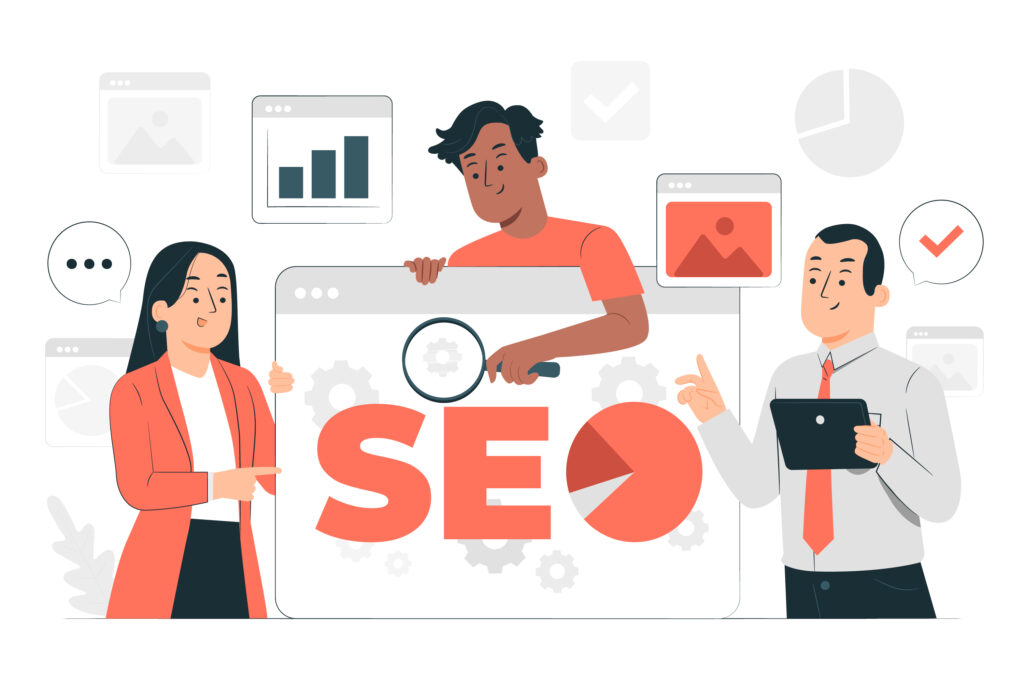What is SEO and Why Does It Matter?
1️⃣ Introduction

Have you ever wondered how websites appear at the top of Google search results? Whether you’re running a blog, an online business, or a personal website, getting noticed on search engines is crucial. This is where SEO (Search Engine Optimization) comes into play.
In simple terms, SEO is the process of optimizing your website to rank higher on search engines like Google. The better your SEO, the more visitors you can attract—without paying for ads.
In this beginner’s guide, we’ll break down how SEO works, key ranking factors, and simple SEO strategies that anyone can implement.
2️⃣ How Search Engines Work

Before diving into SEO strategies, let’s first understand how search engines work.
🔍 How Does Google Rank Websites?
Google uses automated bots (called crawlers or spiders) to scan billions of web pages. These bots analyze content, structure, and other factors to decide how relevant a page is to a search query.
🔄 Crawling, Indexing, and Ranking Explained
✅ Crawling → Google bots discover new and updated pages.
✅ Indexing → The collected pages are stored in Google’s database.
✅ Ranking → Google ranks pages based on relevance & quality.
💡 Pro Tip: If your website isn’t indexed, it won’t appear in search results! You can check your site’s index status using Google Search Console.
3️⃣ Key SEO Factors You Need to Know
SEO consists of three main categories:
📌 On-Page SEO vs. Off-Page SEO Comparison Table
| Factor | On-Page SEO 🔍 | Off-Page SEO 🌍 |
|---|---|---|
| Definition | Optimization done within the website | Actions taken outside the website to improve ranking |
| Focus | Content, keywords, structure, and user experience | Building authority, trust, and reputation |
| Main Elements | – Title tags & meta descriptions – High-quality content – Internal linking – URL structure – Page speed & mobile-friendliness | – Backlinks from other websites – Social media shares & mentions – Guest blogging & PR – Brand signals & online reputation |
| Examples | – Optimizing blog posts for target keywords – Using header tags properly (H1, H2, H3) – Ensuring a fast-loading & mobile-friendly site | – Earning backlinks from authoritative sites – Promoting content through social media – Engaging in influencer collaborations |
| Tools to Use | – Yoast SEO (WordPress plugin) – Google Search Console – Google PageSpeed Insights | – Ahrefs (Backlink analysis) – SEMrush (Link building) – BuzzSumo (Content marketing) |
| SEO Impact | Direct impact on site quality & relevance | Helps build credibility & domain authority |
| Which One is More Important? | ✅ Essential for content & user experience | ✅ Crucial for ranking & trust-building |
📌 1. On-Page SEO (Optimizing Your Website Content)
These are actions you take inside your website to improve rankings:
- Title Tags & Meta Descriptions → Clear & keyword-optimized
- High-Quality Content → Informative, engaging, and valuable 👉 Best AI Productivity Tools – Top 5 Must-Try Tools (2025)
- Keyword Optimization → Using the right keywords naturally
- Internal Linking → Linking to other relevant content on your site
📌 2. Off-Page SEO (Building Authority Outside Your Website)
These are actions taken outside your website to boost credibility:
- Backlinks → Getting links from reputable websites
- Social Signals → Shares, likes, and engagement from social media
- Brand Mentions → Online mentions of your site without links
📌 3. Technical SEO (Improving Website Performance)
These are factors that affect search engine crawling and indexing:
- Mobile Optimization → Mobile-friendly design is a must!
- Website Speed → Faster websites rank better (Use Google PageSpeed Insights)
- Secure Website (HTTPS) → Google favors sites with SSL certificates
4️⃣ Simple SEO Strategies for Beginners
Now that you understand SEO basics, let’s go step by step to optimize your website.
✅ Step 1: Optimize Your Website Structure
- Use clean & user-friendly URLs (e.g.,
yourwebsite.com/seo-guide) - Ensure easy navigation and mobile responsiveness
✅ Step 2: Do Keyword Research (Find What People Search For)
- Use Google Keyword Planner, Ubersuggest, or Ahrefs
- Find low-competition, high-volume keywords for better ranking
✅ Step 3: Write High-Quality, SEO-Optimized Content
- Answer searcher intent → Provide real value
- Use headings (H1, H2, H3) properly
- Include keywords naturally without keyword stuffing
✅ Step 4: Improve Website Speed & Mobile Friendliness
- Compress images using WebP format
- Use a lightweight WordPress theme (GeneratePress, Kadence, etc.)
✅ Step 5: Build High-Quality Backlinks (Off-Page SEO)
- Write guest posts on relevant blogs
- Get featured on Reddit, Quora, and LinkedIn
- Reach out to influencers & websites for collaborations
5️⃣ Best Free SEO Tools for Beginners
If you’re new to SEO, don’t worry! There are several free tools that can help you optimize your website.
✅ Google Search Console → Track & fix indexing issues
✅ Google Keyword Planner → Find trending search terms
✅ Yoast SEO (WordPress Plugin) → Optimize blog posts easily
✅ Ubersuggest → Free keyword & SEO analysis
💡 Pro Tip: Start with Google Search Console & Yoast SEO if you’re using WordPress!
6️⃣ Conclusion & Next Steps
SEO is an ongoing process, not a one-time task. By following the simple strategies in this guide, you can improve your website rankings, get more organic traffic, and grow your online presence.
🚀 Want more SEO & online business tips?
👉 Check out our article on Best AI Productivity Tools
📌 Start optimizing your site today! SEO success is closer than you think.
👉 “Want to improve your website’s productivity? Check out our guide on AI Productivity Tools to automate your SEO workflow!”
